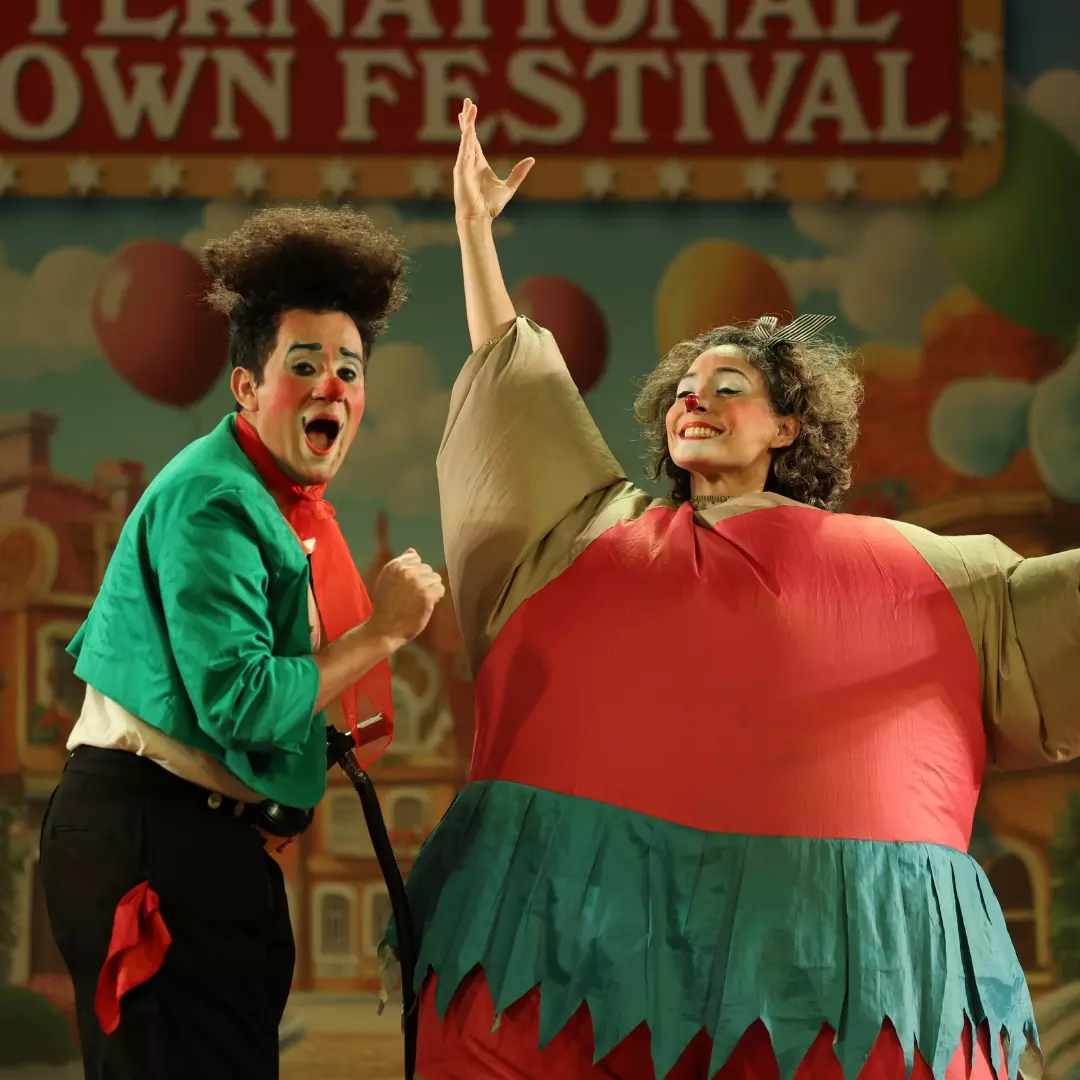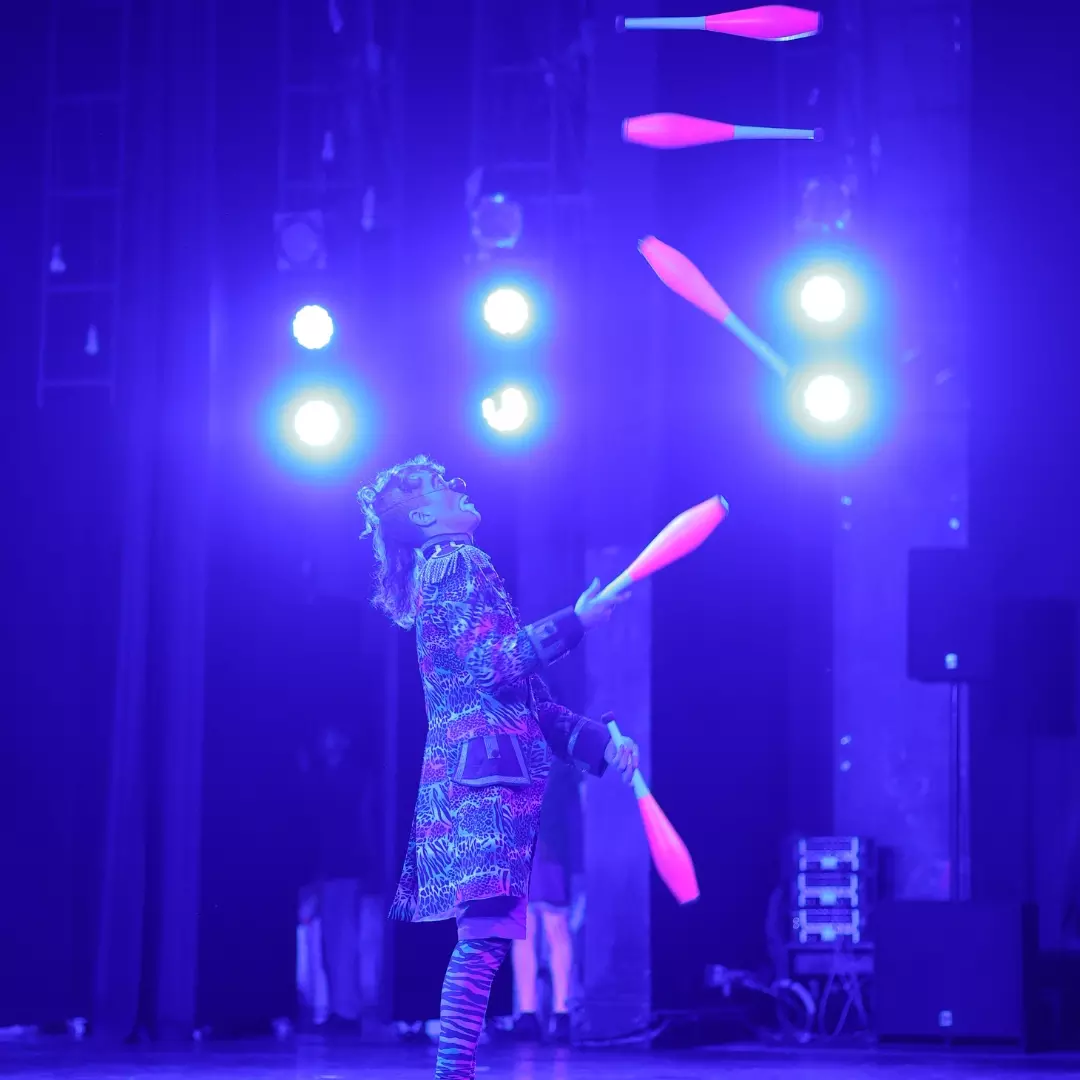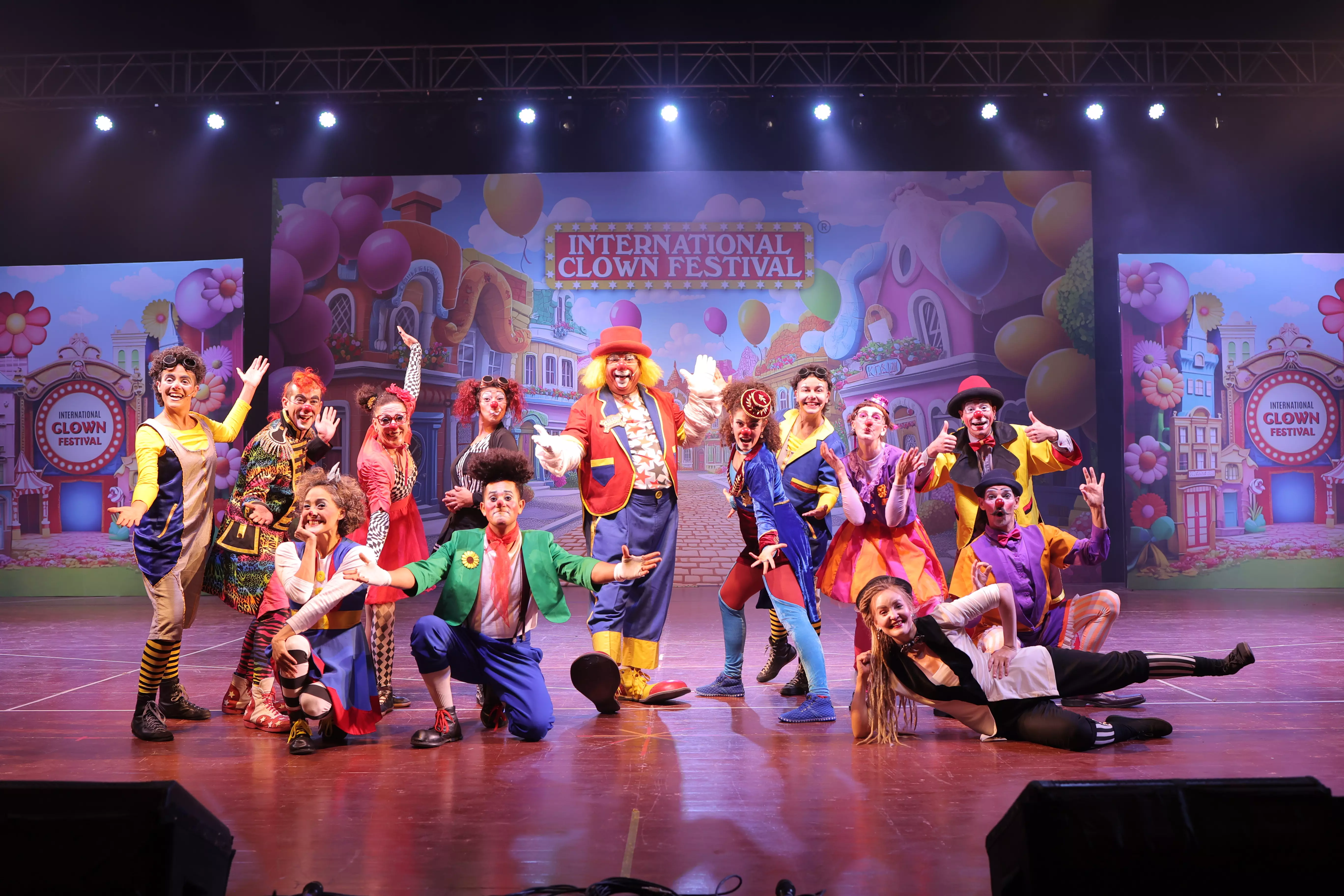
- Home
- India
- World
- Premium
- THE FEDERAL SPECIAL
- Analysis
- States
- Perspective
- Videos
- Sports
- Education
- Entertainment
- Elections
- Features
- Health
- Business
- Series
- In memoriam: Sheikh Mujibur Rahman
- Bishnoi's Men
- NEET TANGLE
- Economy Series
- Earth Day
- Kashmir’s Frozen Turbulence
- India@75
- The legend of Ramjanmabhoomi
- Liberalisation@30
- How to tame a dragon
- Celebrating biodiversity
- Farm Matters
- 50 days of solitude
- Bringing Migrants Home
- Budget 2020
- Jharkhand Votes
- The Federal Investigates
- The Federal Impact
- Vanishing Sand
- Gandhi @ 150
- Andhra Today
- Field report
- Operation Gulmarg
- Pandemic @1 Mn in India
- The Federal Year-End
- The Zero Year
- Science
- Brand studio
- Newsletter
- Elections 2024
- Events
Flubber the Clown on the possibilities of clowning in India

A couple of years ago when Martin D’Souza, popularly known as Flubber the Clown, was performing with his troupe in Mumbai, a pregnant woman walked onto the stage. She held the hands of a female clown of the troupe and made them touch her belly, and said, “I never laughed in my life, but today I did it all because of you.” She wanted the offspring to be born as the happiest child.In...
A couple of years ago when Martin D’Souza, popularly known as Flubber the Clown, was performing with his troupe in Mumbai, a pregnant woman walked onto the stage. She held the hands of a female clown of the troupe and made them touch her belly, and said, “I never laughed in my life, but today I did it all because of you.” She wanted the offspring to be born as the happiest child.
In another incident, an 80-year-old woman walked with Martin and others through the mall for a long time once the show got over. There are many such stories and the list never ends as Martin has been performing as a clown for the last 34 years in various cities in India as well as abroad. Although clowning is not popular in India, the possibilities that this art form offers are immense, according to Martin, the only certified professional clown in India who won the International Clown of the Year award in 2016.

A scene from the International Clown Festival in Bengaluru.
With a passion for bringing clean family entertainment to kids and parents, Martin launched the International Clown Festival (ICF) in 2010. The festival has been held in various cities in India, providing entertainment to kids, parents and senior ‘kids’ since then. Martin has trained many children and adults on various skills of clowning, mime, juggling, unicycling and comedy. He also introduces renowned foreign clowns from across the world during the festival. The recently held ICF evoked tremendous response in cities like New Delhi, Mumbai, Chennai and Bengaluru.
Why do we see only ‘jokers’ not clowns in India? “It’s our mindset,” said Martin. “Clowning is popular in countries abroad and many do it as their full-time career. But in India, we were only aware of clowns in circuses. But today, it is changing. Clowns are being used to provide entertainment as well as messages in various fields say corporate, industry and education etc,” said Martin, a native of Mumbai, who is former vice president of the World Clown Association and the curator and producer of the ICF.
Even though clowning began with the circus, it gradually spread into other fields such as theatre and entertainment in countries like the US, where Martin studied clowning at the University of Lacrosse Wisconsin, USA. He has a BSc in physics and a Master’s degree in marketing. “In the US, I found clowning as a respected profession. It was an eye-opener for me as I looked at the possibilities of the art form. There was a large body of work in various forms available for clowns in the theatre troupes there. Clowns also performed at carnivals, fairs and corporate events. They were widely used for teaching life skills and values in schools. The most interesting was a system where “clowns on call” were made available to hospitals to calm patients who suffer from accidents and other serious illnesses. The clown doesn't need to jump or laugh in the hospitals, a mere presence of him will serve the purpose,” said Martin, who has been to many hospitals to provide relief to the patients there.

The International Clown Festival in Chennai.
A clown’s job, according to him, is challenging. He or she needs to develop special skills and character. “A clown is an all-rounder who knows multiple skills and is able to adapt to any environment. He has to develop a character and he has to do justice to it with his skills and talent. It is a huge world of entertainment. The area of work is tremendous in the field of a clown,” he said.
It was while studying in the US that he realised how the artists there gave importance to details, right from the shoes that they wore to make-up, costumes and presentation. “In India, we never experienced such a professional attitude when it came to clowning. People had not even heard of ‘clowning’. You can’t talk about it until you go and see it. It was this thought that triggered me to launch the International Clown Fest,” said Martin. When he asked his friends, they said they would come with him and perform in India. “I brought famous international clowns to India to show the importance of the art form to the Indian audience. As I was vice president of the WCA, I maintained contacts with many international clowns. I was able to bring 12 clowns from various parts of the world to India in the first show of the ICF,” he added. Bungles, Timmyto, Timmy Bond, Toto, Benji, Maggie, Ez, Kozee, Sparky, Sam Tee, Puff, Dee Dee, Mr Stripes, Kristy, Raciel, Bubbels, Mr Parks, Kiwi, La Ditzy, Rollow, Lolo, Patty, Jojo and Nellie Bellie are some of the international clowns who had visited India as part of the ICF.
The ICF is an annual festival that aims to showcase the art of clowning while providing a fun and engaging experience for attendees of all ages. It is a gathering of international clowns from across the world. The ICF features a talented lineup of award-winning professional clowns, interactive performances, workshops, games, and various entertainment activities. The idea is to spread laughter, promote community engagement, and support local charitable initiatives. Martin’s troupe has performed at theatres, malls, schools, hotels and carnivals in various cities in India. Martin also conducts workshops on clowning, juggling, circus and comedy. As clowns come from different countries, they bring in different styles. The ICF has done more than 500 shows in various cities in India so far. Martin said there is huge potential when it comes to clowning in India today.

The ICF features a talented lineup of award-winning professional clowns, interactive performances, workshops, games, and various entertainment activities.
There are three main types of clowns in the US and they are “Whiteface Clown", “Auguste Clown” and “Tramp Clown”. While Whiteface style is considered the oldest, Auguste is a mixture of Whiteface and Tramp. Martin follows the Auguste style of clowning. Even though Martin has been organising the ICF since 2010, he has never got a single sponsor so far. Considering the cost of running a festival like ICF every year Martin badly wants sponsors but nobody is willing to come forward. “In India, neither the sponsors nor the brands want to get associated with clowns. They don’t know the possibilities of clowning. The mindset also matters. We see clowns as jokers and we look down upon jokers. When we have misconceptions and prejudices against clowns and jokers, we treat them badly. I am proud to say that I am a clown,” he said.
There is also a reason why clowns are not given the respect that they deserve in India. The clowns in India, according to Martin, don’t know how to present themselves. The clowns in India don’t want to give importance to their costumes and make-up. Their costumes are shabby and dirty. They don’t know how to present themselves. If we look good and we are presentable, then people will treat us with respect. My experience abroad taught me how to present myself as a clown. And that’s why children come and hug me during my shows. If your costume is dirty, who will come to you? It is not a matter of rich or poor. A clean costume has nothing to do with money. It is all about one’s attitude. In India, clowns don’t know how to present themselves,” said Martin, speaking on the challenges of clowning in India.
What did Martin do to solve this crisis? “I have been giving training to many students. But it was not easy. Many students told me that they didn’t want to be a clown. They said people would make fun of them. By providing beautiful, clean costumes to each, I was able to change them. When they found them in a respectable costume, they were ready to perform. And it was a journey from a challenge of ‘people making fun of us’ to be respectable on stage,” he said. When you become a superstar on stage, you will see people come to you and respect you. “Lot of girls and boys who worked with me started thinking that ‘I am now an entertainer.’ When you are an entertainer, you are at a higher level compared to others. But when you think you are just a joker and a clown, then you place yourself low. That’s the challenge that we have to overcome as a clown as well as a performer,” said Martin, who runs the Lighthouse Entertainment and Mad Hatters, the Family Entertainment Company.
"As an art form, we have to own it and respect it and believe in that art form. You see other entertainers, you see they themselves are not happy with what they are doing. So once you are happy and you respect your profession, keep it clean, then grow depending on the skills that you have. Some may be good jugglers, some may be good unicyclists and some may be good magicians. And that’s how the art form is growing slowly today. I am performing across the county now and the people are noticing the good source of entertainment that we provide and that’s why they are coming to us. It is a very positive trend,” he added.
In the show, Martin immortalises a bubbly, vibrant eight-year-old boy. However, he puts ‘eleventy-eleven’ (an indefinite large number) on the age column of his bio. “I follow the Auguste clown style. There are bright colours of red, blue and yellow that I adopted. My character is a bubbly young eight-year-old, who is known for his silliness. ‘How can you be so silly,’ I was asked once by a group of students for which I said, ‘I am silly, but thank you for pointing it out.’ So everybody believes in the creation of a character. My costume has to match with my character. I use a top hat and a pair of expensive shoes that I brought from the clown schools abroad. I don't change my style quite often so I stick to it. Artists choose colours based on their taste. But the point is it has to get along with their personality,” he said.
Even though clowning as an art form is gaining momentum in India, no university or colleges offer any course to study it. However, there are workshops and training courses for clowning organised by some theatre troupes in India. But it follows the theatre style of entertainment. Why are there no clowning schools in India? “It costs a lot of money to run a clowning school,” said Martin, who has performed in countries like the USA, Canada, China, Malaysia, Thailand, Ireland and Dubai. “I have been teaching students but it costs a lot of money to set up a school,” he added.
Martin performs at carnivals, events, corporate family days, special appearances, movies, advertisements, films and reality shows. He also visits hospitals and institutes as a ‘Caring Clown’. He teaches clowning and entertainment to kids, youth and young adults, who in turn are employed with the company for various events. Martin is happy that the ICF evoked tremendous response. “It is a family show and we are focused from the toddler to senior citizens in the family. In Goa, many senior citizens came to our show. We are getting invites from not only from big cities but also from small towns in India. The trend is positive and it shows how the art form is progressing,” said Martin.
